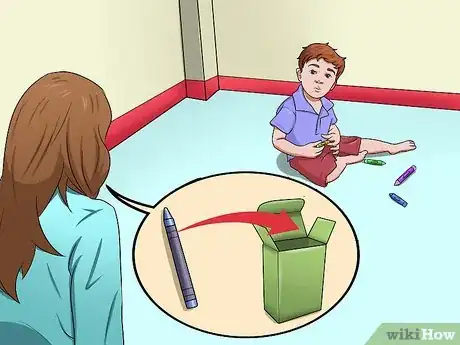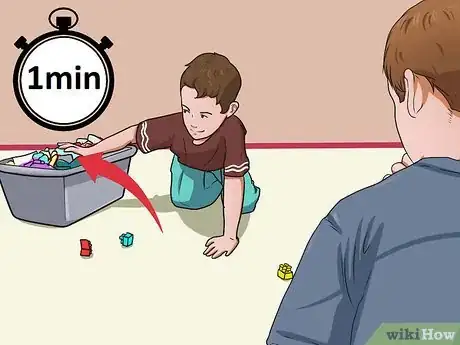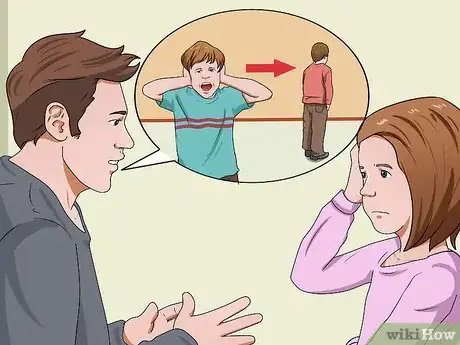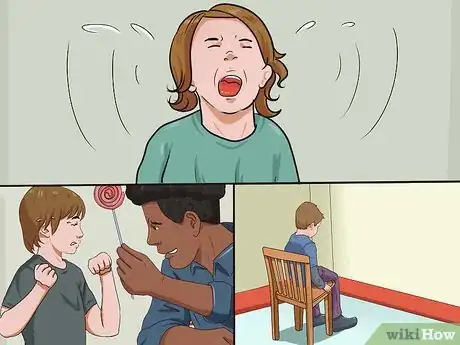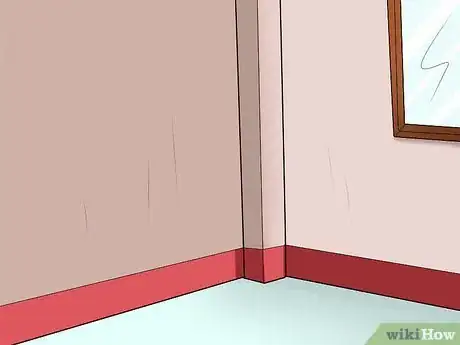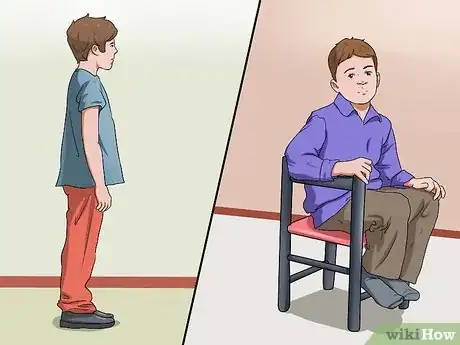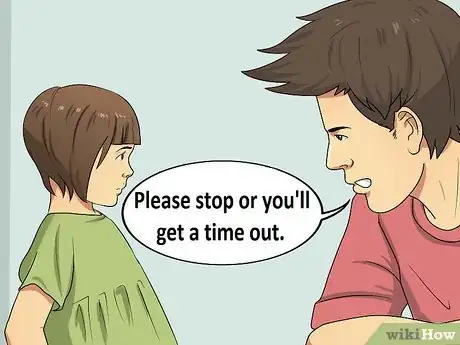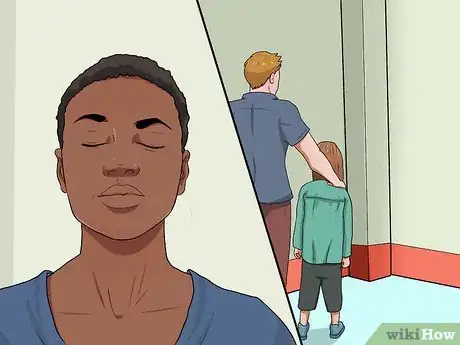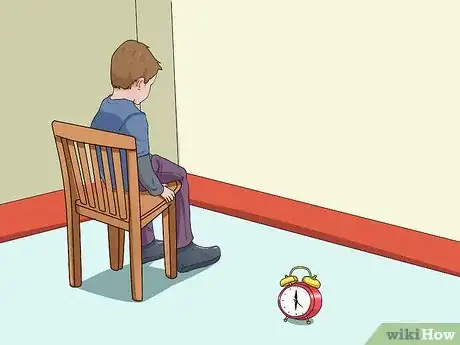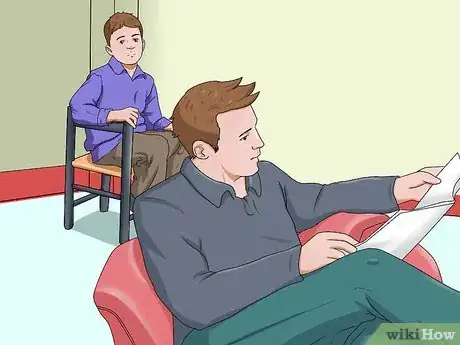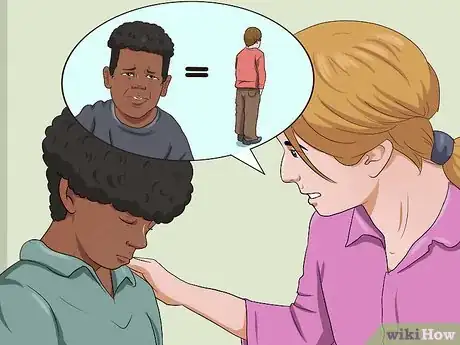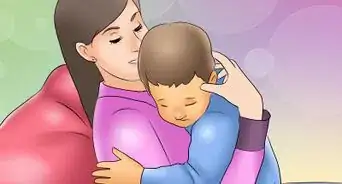This article was co-authored by Kathy Slattengren, M.Ed.. Kathy Slattengren is a Parent Educator and Coach and the Founder of Priceless Parenting. With over two decades of experience, Kathy specializes in helping parents build strong, loving relationships with their children. She has helped thousands of parents around the world through Priceless Parenting's online classes, presentations, coaching, and books. Kathy holds a Bachelor's degree in Computer Science and Psychology from The University of Minnesota and a Masters degree in Education and Instructional Design from The University of Washington. Kathy is a member of the National Parenting Education Network, the US Alliance to End the Hitting of Children, the International Society for Technology in Education, and a founding member of Parent Learning Link. Priceless Parenting has been featured on ABC News, Komo News, King 5 News, National PTA, Parent Map, and Inspire Me Today.
There are 7 references cited in this article, which can be found at the bottom of the page.
This article has been viewed 30,415 times.
Do you have a child that is not complying with your instructions or misbehaving but you don't want to use harsh punishments? Time-outs can be effective in dealing with non-compliance and many parenting training programs teach these skills.[1] This strategy works best for ages 3-8 but could be changed slightly for older children.
Steps
Communicating Appropriately with Your Child
-
1Be clear about your expectations. The more clear you are, the less confusion may occur and thus less avoidable conflict with your child.
- For example, if you want your child to put his crayons away and you say, “Make sure you put those away,” your child may be confused and not understand what you want him to do. However, if you say something like, “Johnny, please put your crayons away in your crayon box right now,” your child knows exactly what you are referring to, when you want it to happen, and where to put it.
-
2Give your child enough time to comply with requests. Studies show that parents may not give their children enough time to respond to a request or command.[2]
- Make sure the amount of time you give the child fits the command. For example, if you asked your child to put away his crayons, give him adequate time to complete this task. He will need to pick up his crayons, fit them all into the box, and then put the box away. Given that he is a child, this will take longer for him to do. Giving him only 5 seconds to do this is not enough time; 1 minute might be more appropriate.
Advertisement -
3Explain what behaviors may lead to a time-out. Children need to understand the boundaries and what the consequences are if they break those boundaries. If the child anticipates the time-out, it is more likely to result in compliance over time.[3]
- When you are initiating the new rule of time-outs in your household, you can explain to your child the types of behaviors that might land him in time-out. For example, you could say something like, “Johnny, we’re going to try something new. Lately, I’ve noticed that you sometimes don’t obey me when I tell you to do something. If that happens, I may ask you to go to time-out.”
- Give specific example such as, “Certain things might lead to a time-out. Some things you’ve done lately are when you didn’t put your crayons away when I asked you to, and when you screamed in the store because I said you couldn’t have a toy.” You can explain your reasoning by saying, “Since these types of things are happening, we need to try something new.”
Preparing for the Time-Out
-
1Recognize the utility of time-outs. Children who act out have learned that their behaviors (such as tantrums) get them what they want (for the parent to give in).[4] Some children want attention, while others simply want an item or piece of candy. The removal of attention received when giving a time-out may be the reason for increased compliance in the child. [5] Time-outs don’t have to be viewed as punishments, but as the removal of parental behaviors that were previously reinforcing the child’s negative behavior (giving in to buying the item, letting the child have the candy, or giving up).
-
2Find a good location for the time-out. Find an empty spot in your home. Make sure it is in a low-traffic area like a rarely-used room or a corner.
- For a more positive approach, create a "quiet space" with soft pillows, music, and toys where your child can go to calm down during a tantrum.[6]
- Depending on your preference and culture, you might want to name the time out area the “thinking chair,” or “time-out corner.”[7]
- You can let your child know ahead of time that this area is going to be his “thinking spot” where he can go sometimes if he does not comply with your instructions appropriately (refusing to do what he is told, or having a tantrum).
-
3Decide on boundaries for the time-out. Planning out exactly how you want the time-out to happen will help ensure that it runs smoothly.
- Decide whether to let children sit or stand. Standing is a slightly harsher punishment as it can be tiring. For standing, don't put anything in the area. For sitting, place a stool or small chair.
- Do not allow the child to talk to you during the time-out.
- Decide what you want to tell your child to think about while he is in time-out. You can tell him to think about how he can work on staying out of time-outs, or what you can do together (collaborative problem solving) to make sure his behaviors are good so he doesn't have to go to a time-out. Focus on what he can do better instead of telling him to, "think about what you did wrong," as this can be shaming.
- Have them face the wall. This is so that they cannot get any reinforcement from you or another family member.
- Decide on the amount of time for a time-out. For every year of age there should only be 1 minute of time out given. For a 4 year old, 4 minutes of time out is appropriate.[8]
Effectively Using the Time-Out Strategy
-
1Give the child the opportunity to correct the behavior first. Next time your child misbehaves, first ask him to stop the behavior. Say, "Please stop playing with your crayons and put them away. If you don't stop, you'll have to take a time-out."
- Emphasize that the child has a choice, to stop the behavior (or do the behavior you want) or go to time-out.
- Count out loud in order to give the child time to correct his behavior.[9] Let the child know that if he does not comply then on the count of 5 he has to go to time-out. Say something like, “I’m going to count to 5, and if you haven’t done what I asked you by the time I say 5, you have to go to time-out.” Count slowly, or give extra counts (Count to 10, or give him 30 seconds) to give the child enough time to complete what you asked.
- If the behavior stops, then a time-out is not necessary.
-
2Direct the child to the time-out area. If your child does not comply with your request in a reasonable amount of time, let the child know that he now has to go to time-out. Tell the child what you would like him to do - either sit on the stool/chair or stand.
- Try to remain calm and don't be rough with your child. Simply take him to the time-out area.
- Tell your child what you previously decided for him to think about while he's in time out. Remember to avoid telling him to think about what he did wrong and instead say something like, "Try to think about how we can make this better so that you don't have to go to time-out next time. When you're done with your time-out we can talk about it."
- Manage your own emotions. Your child may continue to kick, scream, or cry as he does not want to go to time-out. Remind yourself that you need to be consistent and that it would be worse to give in to him at this point; this is because it would reinforce his negative behaviors and teach him that the more he screams or cries, the better chance he will get what he wants.
-
3Set and keep the time limit. Tell your child how long his time-out out will be.
- Do not let the child leave the time-out early! This will reinforce that if he begs you or tantrums further, he will eventually get what he wants.
- Use a buzzer (or sound on your cell phone) if your child attempts to leave time-out early. This helps to manage the time-out more effectively and set appropriate boundaries.[10]
- If the child attempts to leave the time-out, give a warning. Say something like, “You were instructed to stay in the time-out until the time is up. If you don’t do this, you will go into the holding chair (or a room alone).” The holding chair is where you would need to physically hold the child down in the chair (not hurting them of course), or stand right next to the chair until the time is up. Another option is to have them spend the rest of their time-out in a room alone.
-
4Do something else but continue to monitor your child. Consider leaving the room or going about your daily tasks. However, stay close enough that if your child leaves the time out area or starts talking to another family member, you will know.
- It is important that you do not give your child attention during the time-out because this could reinforce his negative behavior.[11]
- Stay strong. It can be very difficult to see your child cry or scream, or hear him beg or suffer. Use your own coping skills to tolerate these behaviors. Think realistically about the situation. Ask yourself, “Is my child really in pain right now or just upset that he did not get what he wanted?”
-
5Recap the situation and plan for the future. Once the time out is over, approach the child and remind him why he was in time out.
- Tell him that the time out is over and he can go back to playing, but if he does that behavior again, he will have a time out again. Be consistent and don’t back down!
- Use collaborative problem solving.[12] Time-outs alone may not be enough to completely extinguish a negative behavior. Try problem-solving with your child by asking, “What do you think we need to do in order to stop these time-outs from happening?” If your child says something like, “Just stop doing them,” you can respond by saying, “The point of the time-outs are to correct your behavior, remember? What do you think we can do about that?”
- Use positive reinforcement. Positive reinforcement is where you give your child a reward in order to increase positive behaviors. For example, you could say something like, “If you make sure to put your crayons away for one whole week then we will go out for ice-cream.” Positive reinforcement tactics like these may reduce the amount of time-outs needed and increase positive behaviors.
Expert Q&A
-
QuestionAre time-outs harmful?
 Kathy Slattengren, M.Ed.Kathy Slattengren is a Parent Educator and Coach and the Founder of Priceless Parenting. With over two decades of experience, Kathy specializes in helping parents build strong, loving relationships with their children. She has helped thousands of parents around the world through Priceless Parenting's online classes, presentations, coaching, and books. Kathy holds a Bachelor's degree in Computer Science and Psychology from The University of Minnesota and a Masters degree in Education and Instructional Design from The University of Washington. Kathy is a member of the National Parenting Education Network, the US Alliance to End the Hitting of Children, the International Society for Technology in Education, and a founding member of Parent Learning Link. Priceless Parenting has been featured on ABC News, Komo News, King 5 News, National PTA, Parent Map, and Inspire Me Today.
Kathy Slattengren, M.Ed.Kathy Slattengren is a Parent Educator and Coach and the Founder of Priceless Parenting. With over two decades of experience, Kathy specializes in helping parents build strong, loving relationships with their children. She has helped thousands of parents around the world through Priceless Parenting's online classes, presentations, coaching, and books. Kathy holds a Bachelor's degree in Computer Science and Psychology from The University of Minnesota and a Masters degree in Education and Instructional Design from The University of Washington. Kathy is a member of the National Parenting Education Network, the US Alliance to End the Hitting of Children, the International Society for Technology in Education, and a founding member of Parent Learning Link. Priceless Parenting has been featured on ABC News, Komo News, King 5 News, National PTA, Parent Map, and Inspire Me Today.
Parent Educator & Coach Timeouts can be harmful if you give them at the wrong time. For instance, putting your child in timeout whenever they get upset might teach them that it's not okay to express emotions. Instead, create a quiet, calming area where they can calm down whenever they're upset.
Timeouts can be harmful if you give them at the wrong time. For instance, putting your child in timeout whenever they get upset might teach them that it's not okay to express emotions. Instead, create a quiet, calming area where they can calm down whenever they're upset. -
QuestionWhat is the purpose of a time-out?
 Kathy Slattengren, M.Ed.Kathy Slattengren is a Parent Educator and Coach and the Founder of Priceless Parenting. With over two decades of experience, Kathy specializes in helping parents build strong, loving relationships with their children. She has helped thousands of parents around the world through Priceless Parenting's online classes, presentations, coaching, and books. Kathy holds a Bachelor's degree in Computer Science and Psychology from The University of Minnesota and a Masters degree in Education and Instructional Design from The University of Washington. Kathy is a member of the National Parenting Education Network, the US Alliance to End the Hitting of Children, the International Society for Technology in Education, and a founding member of Parent Learning Link. Priceless Parenting has been featured on ABC News, Komo News, King 5 News, National PTA, Parent Map, and Inspire Me Today.
Kathy Slattengren, M.Ed.Kathy Slattengren is a Parent Educator and Coach and the Founder of Priceless Parenting. With over two decades of experience, Kathy specializes in helping parents build strong, loving relationships with their children. She has helped thousands of parents around the world through Priceless Parenting's online classes, presentations, coaching, and books. Kathy holds a Bachelor's degree in Computer Science and Psychology from The University of Minnesota and a Masters degree in Education and Instructional Design from The University of Washington. Kathy is a member of the National Parenting Education Network, the US Alliance to End the Hitting of Children, the International Society for Technology in Education, and a founding member of Parent Learning Link. Priceless Parenting has been featured on ABC News, Komo News, King 5 News, National PTA, Parent Map, and Inspire Me Today.
Parent Educator & Coach Time-outs give both you and your children a chance to regroup after an intense conversation.
Time-outs give both you and your children a chance to regroup after an intense conversation.
Warnings
- Older children may refuse to go into time out. If so, give them a worse punishment after a warning.⧼thumbs_response⧽
References
- ↑ http://scholar.harvard.edu/jweisz/files/2001e.pdf
- ↑ http://dare.ubvu.vu.nl/bitstream/handle/1871/18541/Kalb_Pediatrics_111_2003_u.pdf?sequence=2
- ↑ http://dare.ubvu.vu.nl/bitstream/handle/1871/18541/Kalb_Pediatrics_111_2003_u.pdf?sequence=2
- ↑ www.yscp.org/new/images/ftomashefski/the%20explosive%20child2.doc
- ↑ http://dare.ubvu.vu.nl/bitstream/handle/1871/18541/Kalb_Pediatrics_111_2003_u.pdf?sequence=2
- ↑ Kathy Slattengren, M.Ed.. Parent Educator & Coach. Expert Interview. 27 July 2021.
- ↑ https://www.researchgate.net/profile/Anna-Lau-2/publication/8484872_RacialEthnic_Differences_in_Caregiver_Strain_and_Perceived_Social_Support_Among_Parents_of_Youth_with_Emotional_and_Behavioral_Problems/links/00463521cfd2cc7fd0000000/Racial-Ethnic-Differences-in-Caregiver-Strain-and-Perceived-Social-Support-Among-Parents-of-Youth-with-Emotional-and-Behavioral-Problems.pdf
- ↑ http://www.ncbi.nlm.nih.gov/pmc/articles/PMC2719514/
- ↑ https://www.infona.pl/resource/bwmeta1.element.elsevier-3842ffaa-b72e-3fc6-b66a-bb57e4e6aa66
- ↑ http://scholar.harvard.edu/jweisz/files/2001e.pdf
- ↑ http://dare.ubvu.vu.nl/bitstream/handle/1871/18541/Kalb_Pediatrics_111_2003_u.pdf?sequence=2
- ↑ www.yscp.org/new/images/ftomashefski/the%20explosive%20child2.doc
